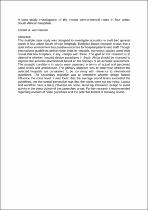 ResearchSpace
ResearchSpace
A case study investigation of the indoor environmental noise in four urban South African hospitals
JavaScript is disabled for your browser. Some features of this site may not work without it.
- ResearchSpace
- →
- Research Publications/Outputs
- →
- Conference Publications
- →
- View Item
| dc.contributor.author |
Van Reenen, Coralie A

|
|
| dc.date.accessioned | 2017-08-22T13:10:24Z | |
| dc.date.available | 2017-08-22T13:10:24Z | |
| dc.date.issued | 2015-11 | |
| dc.identifier.citation | Van Reenen, CA. Proceedings of Meetings on Acoustics, 170th Meeting of the Acoustical Society of America, 2-6 November 2015, Jacksonville, Florida | en_US |
| dc.identifier.uri | http://scitation.aip.org/content/asa/journal/poma/25/1/10.1121/2.0000134 | |
| dc.identifier.uri | http://hdl.handle.net/10204/9471 | |
| dc.description | Copyright: 2015. Acoustical Society of America. Due to copyright restrictions, the attached PDF file only contains the abstract of the full text item. For access to the full item, kindly consult the publisher's website. | en_US |
| dc.description.abstract | This multiple case study was designed to investigate acoustics in multi-bed general wards in four urban South African hospitals. Evidence-based research shows that a quiet indoor environment has positive outcomes for hospital patients and staff. Though international guidelines define noise limits in hospitals, numerous studies world-wide reveal that few hospitals, if any, comply with these. The goal of this research is to determine whether hospital design paradigms in South Africa should be changed to improve the acoustic environment based on the findings of an acoustic assessment. The acoustic conditions in wards were assessed in terms of actual and perceived noise levels and architecture. The primary objective was to determine whether the selected hospitals are considered to be too noisy with reference to international guidelines. The secondary objective was to determine whether design factors influence the noise level. It was found that the average sound levels exceeded the guidelines, yet the overall perception was that the wards were not too noisy. Layout and workflow have a likely influence on noise, requiring innovative design to avoid activity in the direct vicinity of the patient bed areas. Further research it recommended regarding revision of noise guidelines and the potential benefit of masking sound. | en_US |
| dc.language.iso | en | en_US |
| dc.publisher | Acoustical Society of America | en_US |
| dc.relation.ispartofseries | Worlklist;27028 | |
| dc.subject | Acoustics | en_US |
| dc.subject | South African urban hospitals | en_US |
| dc.subject | Hospital noise levels | en_US |
| dc.title | A case study investigation of the indoor environmental noise in four urban South African hospitals | en_US |
| dc.type | Conference Presentation | en_US |
| dc.identifier.apacitation | Van Reenen, C. A. (2015). A case study investigation of the indoor environmental noise in four urban South African hospitals. Acoustical Society of America. http://hdl.handle.net/10204/9471 | en_ZA |
| dc.identifier.chicagocitation | Van Reenen, Coralie A. "A case study investigation of the indoor environmental noise in four urban South African hospitals." (2015): http://hdl.handle.net/10204/9471 | en_ZA |
| dc.identifier.vancouvercitation | Van Reenen CA, A case study investigation of the indoor environmental noise in four urban South African hospitals; Acoustical Society of America; 2015. http://hdl.handle.net/10204/9471 . | en_ZA |
| dc.identifier.ris | TY - Conference Presentation AU - Van Reenen, Coralie A AB - This multiple case study was designed to investigate acoustics in multi-bed general wards in four urban South African hospitals. Evidence-based research shows that a quiet indoor environment has positive outcomes for hospital patients and staff. Though international guidelines define noise limits in hospitals, numerous studies world-wide reveal that few hospitals, if any, comply with these. The goal of this research is to determine whether hospital design paradigms in South Africa should be changed to improve the acoustic environment based on the findings of an acoustic assessment. The acoustic conditions in wards were assessed in terms of actual and perceived noise levels and architecture. The primary objective was to determine whether the selected hospitals are considered to be too noisy with reference to international guidelines. The secondary objective was to determine whether design factors influence the noise level. It was found that the average sound levels exceeded the guidelines, yet the overall perception was that the wards were not too noisy. Layout and workflow have a likely influence on noise, requiring innovative design to avoid activity in the direct vicinity of the patient bed areas. Further research it recommended regarding revision of noise guidelines and the potential benefit of masking sound. DA - 2015-11 DB - ResearchSpace DP - CSIR KW - Acoustics KW - South African urban hospitals KW - Hospital noise levels LK - https://researchspace.csir.co.za PY - 2015 T1 - A case study investigation of the indoor environmental noise in four urban South African hospitals TI - A case study investigation of the indoor environmental noise in four urban South African hospitals UR - http://hdl.handle.net/10204/9471 ER - | en_ZA |





